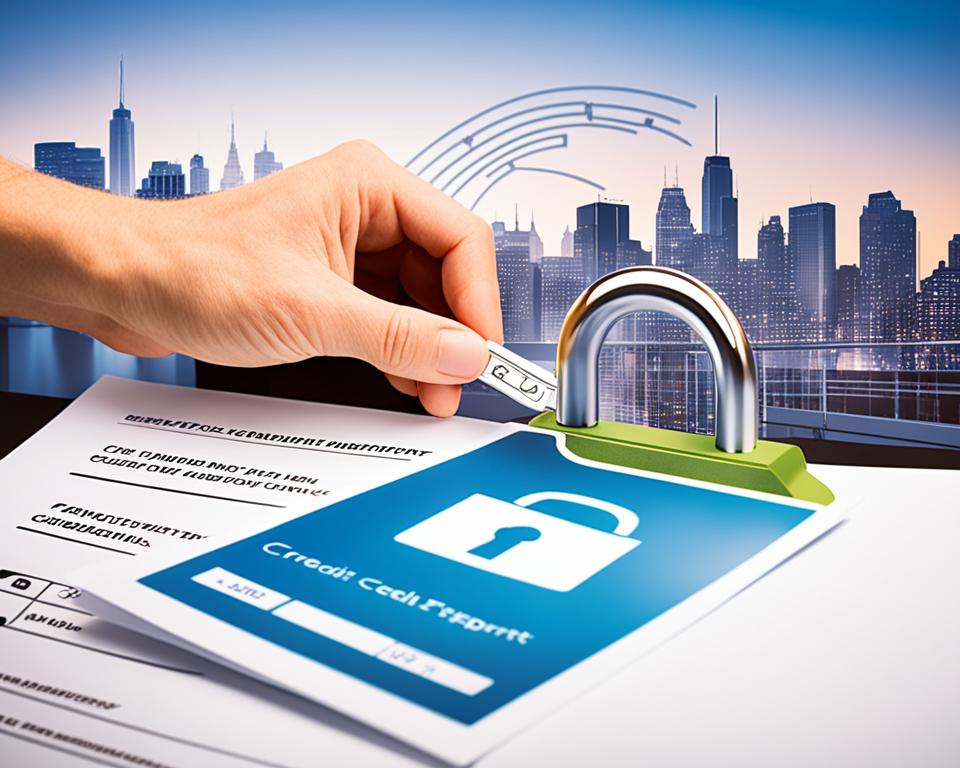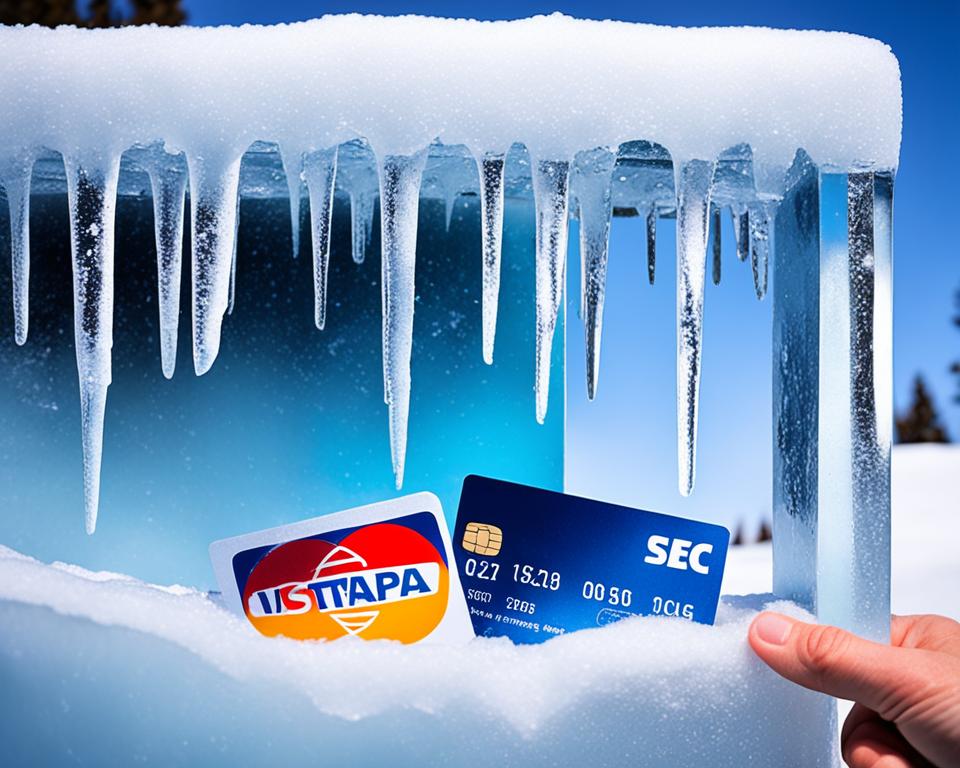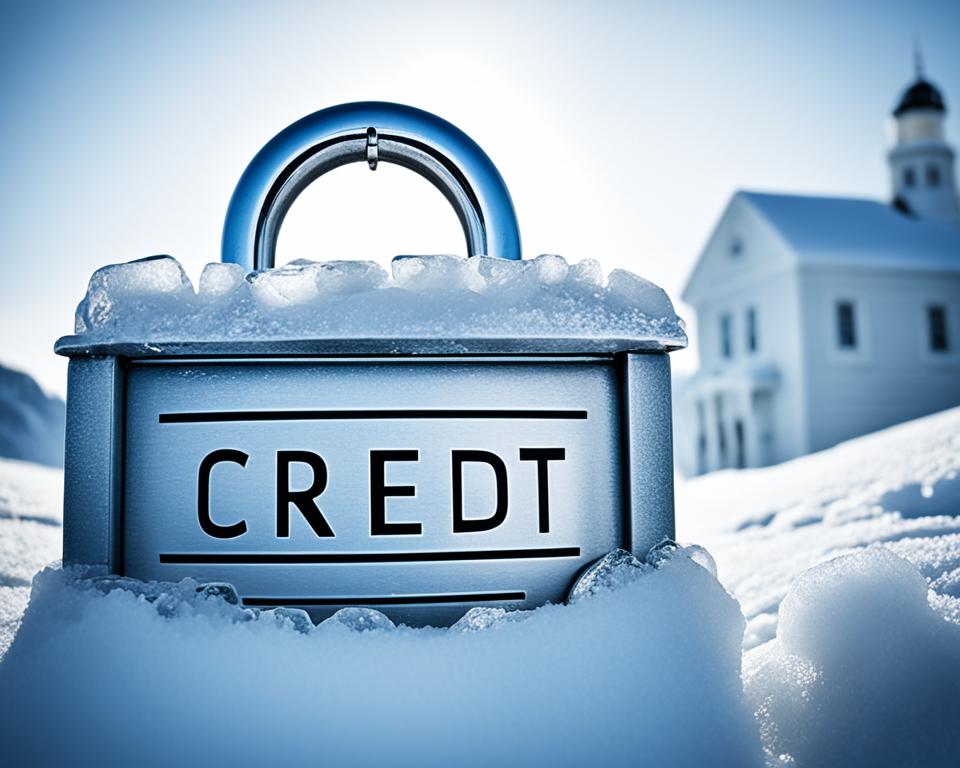Navigating the complexities of financial identity protection can seem daunting, but with the How to Freeze and Unfreeze Your Credit guide, you’re taking a powerful step towards securing your finances. A credit freeze, vital in today’s digital age, acts as a robust shield, guarding your sensitive credit information from unauthorized eyes. Whether it’s preemptive financial caution or a response to a suspected security breach, this credit freeze guide offers clarity and control in protecting your personal data. By freezing your credit, you essentially lock down access to your credit reports, thereby making it exceedingly challenging for identity thieves to misuse your information.
A crucial element of financial identity protection is understanding the balance between securing your credit and maintaining accessibility when you need it. This guide not only simplifies the process of implementing a credit freeze but also illuminates the straightforward steps to unfreeze your credit. Doing so provides peace of mind without sacrificing the flexibility to apply for credit when necessary. The path to secure finances is made clear with expert advice on managing a credit freeze, presenting a formidable barrier against potential fraud and identity theft, at no cost, and with zero impact on your credit score.
Key Takeaways
- A credit freeze is an efficient strategy for financial identity protection.
- Freezing credit won’t damage your credit score and is a free service.
- Unfreezing credit is a straightforward process when you require access.
- Contacting Equifax, Experian, and TransUnion is necessary to fully freeze your credit.
- Stay informed with a comprehensive guide to manage your credit freeze.
- Understand the steps and documentation needed for both freezing and unfreezing credit.
Understanding the Importance of a Credit Freeze
When it comes to shielding your fiscal affairs, the decision to freeze your credit report is a critical and strategic defensive move. This preventative measure is pivotal for those aiming to protect financial identity in an era where digital transactions are the norm. Let’s delve into the intricacies of a credit freeze and unravel its significant role in financial security.
What is a Credit Freeze?
A credit freeze, often perceived as a financial fortress, prevents the scrutiny of your credit report by potential lenders or creditors. By obstructing unauthorized access, it thwarts the efforts of swindlers to exploit your identity. Whether your concerns are proactive or reactive in nature, deploying a credit freeze stands as a bulwark in your pursuit to protect financial identity.
How Does Freezing Your Credit Protect You?
The act of freezing your credit forms an impenetrable barrier to your credit records, thus safeguarding you against the perils of identity theft. This intervention specifically targets the element of accessibility. Without the ability to inspect your credit history, imposters face a near insurmountable obstacle when attempting to orchestrate deceitful ventures like opening up fraudulent accounts.
The Impact of a Credit Freeze on Your Credit Score
An often-misunderstood facet of the credit freeze is its effect on one’s credit score. Contrary to some misconceptions, implementing a freeze does not deleteriously affect your creditworthiness. In essence, it acts purely as a sentinel, vigilantly guarding your sensitive financial details, hence offering credit freeze benefits without compromising your standing in the eyes of prospective creditors.
| Feature | Benefits | Impact on Credit Score |
|---|---|---|
| Access to Credit Report | Restricts unauthorized inquiries and openings of new credit lines | No direct impact, maintains current score |
| Protection from Identity Theft | Diminishes the risk of fraudulent account creation | Creditworthiness intact, provides a secure financial profile |
| Cost | Free service, making it accessible for all consumers | No cost involved, hence no financial strain leading to credit score changes |
In conclusion, employing a credit freeze is a definitive action that serves to freeze your credit score against illicit endeavors without any negative repercussions on your existing credit health. Through this straightforward yet effective method, individuals are empowered to take command of their financial destiny, affirming that their credit remains intact and exclusively within their purview.
Step-by-Step Process to Freeze Your Credit
Taking control of your personal financial security is more important than ever. With identity theft on the rise, the freeze credit process serves as a critical solution for safeguarding your financial information. Let’s navigate the process together, ensuring you know precisely how to implement a protective freeze with each credit bureau.

Freeze Your Credit with Equifax
Initiating an Equifax credit freeze is straightforward. Begin by calling their dedicated freeze number at 800-349-9960 or by visiting the official Equifax website to input your details and request the freeze. By federal law, Equifax is required to apply the credit freeze within one business day if done electronically or by phone, providing you with peace of mind promptly.
Freezing Your Credit with Experian
In the case of Experian, the process for an Experian credit freeze can also be swiftly managed. You have the option of freezing your credit by dialing 888‑397‑3742 or navigating to their secure online portal. As with Equifax, expect your freeze request to be activated within one business day when done online or via phone.
How to Freeze Your Credit with TransUnion
Completing the trifecta with a TransUnion credit freeze ensures that all bases are covered. TransUnion offers you the ability to freeze your credit by calling 800-916-8800 or by using their website to seal your credit report from potential threats. Similar to Equifax and Experian, TransUnion is obliged to enact your credit freeze within a singular business day following an online or telephone request.
| Credit Bureau | Freeze Contact Number | Online Freeze Request | Freeze Timing |
|---|---|---|---|
| Equifax | 800-349-9960 | Available through Equifax’s website | Within one business day |
| Experian | 888‑397‑3742 | Available through Experian’s portal | Within one business day |
| TransUnion | 800-916-8800 | Available through TransUnion’s website | Within one business day |
To ensure that your financial fortress is impenetrable, it’s essential to freeze your credit with all three bureaus — Equifax, Experian, and TransUnion. Remember that while this step is critical for preventing credit fraud, it’s equally important to know how to efficiently unfreeze your credit when you’re ready to apply for new financial opportunities.
How to Freeze and Unfreeze Your Credit
Embarking on the credit freeze process is a prudent move to secure your personal financial data from potential fraud. It restricts unauthorized access to your credit reports, thus forming a vital line of defense against identity theft. In this guide, we have meticulously detailed the steps to both freeze and unfreeze your credit, enabling you to safeguard your information while retaining the flexibility to access new credit as needed.
When you decide that it’s time to unfreeze credit process, the path is just as straightforward. With the advent of digital platforms, learning how to unfreeze credit has become a process that can be completed swiftly and securely, often in the span of an hour if carried out online or via phone. An important point to remember is that you may only need to unfreeze your credit with the specific credit bureau that the potential lender will contact for a credit check.
For your convenience, we’ve compiled a step-by-step approach that encapsulates both the initial freeze and the eventual thaw, should you wish to permit access to your credit file for legitimate reasons. Every step is crucial, as it assures that your credit reports remain impenetrable to unwarranted inquiries until you decide otherwise.
- Initiate the Credit Freeze: Contact each of the major credit bureaus — Equifax, Experian, and TransUnion. This can be accomplished through their respective websites or customer service lines.
- Retain Your PIN or Password: Upon freezing your credit, retain the PIN or password provided; it will be required when you choose to unfreeze your credit.
- Unfreeze Your Credit: When you need to apply for new credit, you can unfreeze your report either temporarily or permanently by using the PIN or password through the bureau’s website or by giving them a call.
- Timing of the Unfreeze: The unfreeze typically goes into effect within one hour if requested online or by phone, allowing rapid access to credit for your financial activities. If using mail, plan ahead as the time frame extends to three business days.
Adhering to these guidelines will help maintain the integrity of your financial profile, deterring any fraudulent attempts with your credit data.
Always remember to promptly reinstate the freeze after obtaining the necessary services. Doing so reaffirms the security of your credit files, ensuring that your exquisite proactive measures continue to shield you effectively from the menaces of identity theft and undue credit scrutiny.
Essential Information for Initiating a Credit Freeze
To effectively initiate a credit freeze, individuals must compile their personal information and provide valid proof of identity, following set verification procedures. A thorough understanding of this process is crucial for safeguarding sensitive credit data. Here’s a walk through the essential preparatory steps for establishing a credit freeze.
Gathering Your Personal Information
Before you can initiate a credit freeze, it’s vital to amass the necessary personal information. This includes your Social Security number, date of birth, and current address. Having these details at your fingertips streamlines the process and ensures accuracy when you make your request to the credit bureaus.
Providing Proof of Identity
To authenticate your identity and proceed with a credit freeze, you might need to supply additional documentation. Acceptable forms of proof include a copy of your passport, driver’s license, or military ID. In some cases, supplemental papers such as tax documents, bank statements, or utility bills are required to substantiate your address.
Understanding Authentication Procedures
When initiating a credit freeze, particularly by phone, you’ll encounter security measures designed to confirm your identity. These measures are integral to the process and may involve answering questions related to your credit history or personal background. Proper identification prevents unauthorized access to your credit files, further protecting you from potential fraud.
| Information Required | Examples of Documents | Usage in Freeze Process |
|---|---|---|
| Primary Identification | Passport, Driver’s License, Military ID | Proof of identity for credit freeze |
| Secondary Identification | Utility bills, Bank statements, Tax documents | Corroborating current residential address |
| Financial Records | Social Security number, Date of Birth | Personal information for credit freeze |
Armed with this guide, you’re now ready to embark on the credit freeze journey. By keeping these credit freeze tips at hand, you can initiate a credit freeze confidently, ensuring that your credit profile is secure from potential threats.
Navigating the Credit Unfreeze Process
When the time comes to grant lenders access to your credit history, understanding how to unfreeze credit report efficiently is key. Whether you’re pursuing a loan, refinancing, or opening a new line of credit, having the know-how to navigate the thawing of your credit freeze via online, phone, or mail channels reduces stress and streamlines the process. Let’s explore the easy steps to manage an online credit unfreeze, phone credit unfreeze, and successful mail credit unfreeze.
Steps to Unfreeze Your Credit Online
Enjoy the convenience of an immediate credit unfreeze with online tools provided by major credit bureaus. A simple login to the bureau’s platform allows you to lift the freeze securely and swiftly. To quickly unfreeze credit reports online, ensure you have your PIN or password at hand. This method is ideal when time is of the essence, such as when a credit decision is pending.
How to Unfreeze Your Credit by Phone
Prefer speaking to a representative? Initiate a phone credit unfreeze by calling the credit bureau’s dedicated line. Have your personal identification information and PIN ready for verification. This alternative delivers a blend of human interaction and promptness, conveniently lifting the credit freeze usually within an hour.
Tips for a Successful Credit Unfreeze by Mail
If you opt for a traditional mail credit unfreeze, a timely approach is crucial. Dispatch the required documentation such as proof of identity and your PIN well in advance. Confirm the mailing address and specific information needed by the credit bureau to avoid delays. Although it takes longer—up to three business days—it’s a solid option when digital or direct communication is not feasible.
| Unfreeze Method | Steps | Needed Information | Estimated Time Frame |
|---|---|---|---|
| Online | Log into the bureau’s website and follow the prompts to remove the freeze. | PIN or password | Within 1 hour |
| Phone | Call the bureau, provide your identification information, and request the unfreeze. | PIN, Social Security number, and date of birth | Within 1 hour |
| Mail the required documents and written request to the bureau. | Proof of identity, PIN, and proof of address | Up to 3 business days |
When to Consider Unfreezing Your Credit
At some juncture, you may find yourself in need of fresh financing or looking to make substantial purchases that necessitate a review of your credit report. When such instances arise, it’s essential to understand the circumstances that call for you to temporarily thaw your credit. Knowing when and how to unfreeze your credit score can be just as important as having it frozen for your protection.

For instance, when you are preparing to apply for a major loan, such as a mortgage or car loan, or perhaps initiate a new cell phone contract, it’s crucial to allow potential lenders to review your credit history. This means you’ll need to facilitate a credit application unfreeze. Similarly, engaging in retail activities that offer “buy now, pay later” options also frequently require a credit check, which is a callback to lift your credit freeze momentarily.
The Right Time to Temporarily Thaw Your Credit
Plan ahead by identifying the specific timings around your credit needs. Should you have a pending application or expect to undertake one soon, arrange for a temporary credit thaw that synchronizes with these events. Doing so could smooth out the application process while maintaining the safety net a credit freeze provides.
Determining Which Bureau to Unfreeze for Credit Applications
Not all credit applications involve enquiring with every bureau. To minimize risks, determine which bureau your lender will check. This selective procedure can ensure you only unwind the freeze on the relevant bureau’s report, thus maintaining the integrity of your defense on other fronts. Ask your potential creditors ahead of time which bureau’s report they will pull, and orchestrate your unfreeze credit score action accordingly.
Strategically Unfreezing Your Credit for Shopping
During shopping seasons or when taking advantage of consumer financing options, strategically plan your credit unfreeze. Such initiatives often involve individual bureaus, and by selectively lifting your freeze, you maintain a robust defense in the overall landscape of your credit security. Set a time limit for these temporary credit thaws to reapply the freeze automatically, ensuring continued vigilance against potential identity theft.
Credit Freeze Tips for Better Financial Security
Ensuring financial security with a credit freeze is a strategic move in contemporary finance management. By effectively setting up and maintaining a freeze on your credit, you mitigate the risks of falling prey to identity theft and credit fraud. The following tips will provide guidance through credit freeze maintenance and help anticipate potential issues that might arise.
Managing Your Credit Freeze Settings
Once you have initiated a credit freeze, it’s imperative to manage your settings diligently. Securing and retaining your unique PIN or login credentials is vital, as these will be required whenever you need to alter your freeze status. To maintain a secure credit file, it’s recommended that you store this information in a secure location, which could be a password manager or a physical safe, to prevent unauthorized access to your credit freeze controls. Efficient credit freeze maintenance involves regular checks to confirm that your security settings remain intact and your credit freeze is active.
Anticipating and Addressing Issues During a Freeze
It’s essential to keep the convenience of a quick-access credit file in mind, especially when new credit opportunities arise. Anticipate the potential need to unfreeze your credit and account for possible delays in accessing new credit. It’s wise to only unfreeze your credit with the specific bureau that a potential lender will check, minimizing risk and exposure. Moreover, while a credit freeze is a robust defense mechanism, it does not shield against fraudulent charges on existing accounts. Regular monitoring of account activity is still necessary to detect any signs of fraud early on.
| Action | Purpose | Benefit |
|---|---|---|
| Store PIN/credentials securely | Ensure you have the ability to manage your credit freeze as needed | Prevents unauthorized changes to your credit freeze |
| Regularly check freeze status | Confirm the security measures are operational | Continuous protection against identity theft |
| Unfreeze only when necessary | Allow credit access for legitimate inquiries | Limits exposure of your credit file |
| Monitor existing accounts | Detect and address fraudulent activity | Early identification of potential threats |
By embracing these practices, you can maintain a high level of financial security with a credit freeze in place. Adjusting your credit freeze settings wisely, planning for potential hurdles, and keeping continuous watch over existing financial instruments are foundational steps to safeguarding your credit health.
The Protective Measures of Child Credit Freezes
In an effort to shield their most vulnerable family members from the threat of identity theft, many parents and guardians are now taking advantage of the option to place a child credit freeze. This preventive step is designed to help block potential misuse before it starts, ensuring a child’s financial integrity remains intact into adulthood.

How to Freeze a Minor’s Credit Report
Fulfilling a minor credit report freeze requires direct contact with the three primary credit bureaus — Equifax, Experian, and TransUnion. This process, tailored for children under the age of 16, involves creating a credit report for the minor if one does not already exist and subsequently activating a freeze. Parents and guardians seeking to utilize this child credit freeze option are responding appropriately to the increasing risk of identity theft targeted towards minors. It’s now integral for guardians to take proactive measures to secure the financial future of children under their care.
Guardianship Requirements for Credit Freezes
To secure a credit freeze guardianship and establish this line of defense, adults must present necessary legal documents. This evidentiary support typically includes the child’s birth certificate, Social Security card, and, for the adult requesting the freeze, proof of guardianship or a court order demonstrating their legal authority. For those in charge of an incapacitated adult’s affairs, similar documentation is required to be mailed to the credit bureaus in order to establish and maintain a credit freeze. Through credit freeze guardianship, the financial wellbeing of those who cannot protect themselves is safeguarded against unscrupulous acts of identity theft.
The vigilance of guardians in setting up a credit freeze for their dependents is an invaluable step toward instilling lifelong financial security. By preparing and submitting the appropriate paperwork, they can ensure that their charges’ financial profiles remain untarnished by the threats of modern-day fraudsters.
Best Practices for Credit Freeze Maintenance
While taking the important step of freezing your credit to protect against identity theft, ensuring you maintain this safeguard is equally crucial. Proper maintenance keeps the freeze effective and your financial peace of mind intact. Vigilant oversight and just a few simple steps can make all the difference in maintaining frozen credit for the long haul.
Routine Financial Monitoring With Frozen Credit
Implementing a routine financial monitoring system is essential when you have a frozen credit. Consistent checks enables you to stay ahead of potential issues that could arise. Services like the free weekly credit reports offered by each of the bureaus or trusted monitoring apps such as Credit Karma present an efficient way to keep an eye on your credit status. Prevent further misuse of your personal information by taking advantage of these tools for continuous defense against any suspicious activity.
The Duration and Maintenance of a Credit Freeze
A credit freeze will remain in place indefinitely until you decide to lift it, be it for a short period or permanently. To manage this effectively, the credentials such as your PINs or login details should be securely stored. This ensures smooth access for when you need to maintain or lift the freeze, whether for updating personal information or responding promptly to legitimate requests for credit access.
- Regularly utilize free credit report offers to keep abreast of any changes or inquiries.
- Engage with credit monitoring services to receive timely updates on your credit status.
- Safekeep your credit freeze credentials to avoid potential hurdles in managing your security settings.
- Remember that credit freeze duration is completely under your control and can be modified as necessary.
Adhering to these best practices for credit freeze duration and maintenance can ensure that your frozen credit remains a robust layer of protection in your financial security strategy.
Understanding the Difference Between a Credit Freeze and Credit Lock
The distinction between a credit freeze and credit lock is particularly important in the realm of financial security. These tools serve a similar purpose—to prevent unauthorized access to your credit reports—yet their subtleties in application and legal standing could significantly impact consumers. Understanding credit freeze vs credit lock is essential for anyone looking to safeguard their financial information.

Comparing Legal Protections and Convenience
Legal protections provided by a credit freeze are substantial, with federal law mandating such freezes to be free and available to all consumers. Credit freezes, once activated, cannot be lifted without your direct authorization, offering a high level of security against identity theft. In contrast, a credit lock is a service voluntarily provided by the credit bureaus that may offer more credit lock convenience, such as the ease of unlocking your credit reports through a mobile app. Despite this convenience, credit locks lack the same level of legal protection as credit freezes, potentially making them less legally binding.
Fee Structures of Credit Locks
While a credit freeze must be provided for free, a credit lock might come with credit lock fees. Companies such as Equifax and TransUnion provide credit lock services, sometimes as part of their subscription packages. The fee for these services, if they apply, may vary based on the level of service offered. When considering a credit lock, it’s important to weigh the cost against the convenience provided to determine which option best suits your personal security needs and financial situation.
| Feature | Credit Freeze | Credit Lock |
|---|---|---|
| Legal Protection | Federally mandated, strong legal status | Voluntary service with less legal status |
| Cost | Always free | May incur fees depending on service level |
| Convenience | Generally managed online or by phone | Often manageable through apps for quick access |
| Activation & Lift Restriction | User must authorize to activate or lift | Can be easily locked or unlocked by the user |
Recognizing Exceptions in Credit Freeze Accessibility
Implementing a credit freeze provides a robust layer of protection for your financial identity, but it’s important to acknowledge that certain entities still retain the right to bypass this security measure. These credit freeze exceptions highlight the need to understand the nuances of frozen credit report access rights to manage your financial strategy effectively.
Who Can Bypass Your Credit Freeze?
The security of a credit freeze is designed to prevent fraud by locking outside access to your credit report. However, existing creditors and authorized entities like debt collectors have the legal ability to access your credit information even when a freeze is in place. This access ensures that they can manage and review accounts as part of their financial operations and obligations.
Access Rights to Your Frozen Credit Reports
Access to your frozen credit report is not entirely exclusive. Along with current creditors and debt collectors, other entities can request your report under specific circumstances. This includes companies sending out preapproved credit offers, certain government agencies, and child support agencies. Furthermore, employers or potential employers are legally allowed to conduct credit checks for employment-related background screenings, provided they have your consent. Understanding these exceptions underscores the importance of continuing to monitor your credit regularly, as a credit freeze does not restrict credit report access during freeze to these entities.
- You: You can always access your own report even when it’s frozen.
- Current Creditors: For ongoing account management purposes.
- Debt Collectors: When they’re collecting on debts you owe.
- Preapproved Credit Offers: Marketers can still make preapproved offers.
- Government Agencies: In cases pertaining to court orders, warrants, or subpoenas.
- Child Support Agencies: When determining child support payments.
- Employment Background Checks: Prospective employers, with your permission.
It is critical to recognize these credit freeze exceptions and understand that while a credit freeze is an excellent tool for protecting against certain types of financial fraud, it does not completely seal off your financial profile. Stay informed about which parties can access your report during a freeze, and take proactive steps to manage the security of your credit information effectively.
Addressing the Misconceptions of Credit Freezes
Amid growing concerns over financial identity theft, credit freezes have become a widely discussed tool for protecting personal information. However, there are several myths about credit freezes that merit clarification to ensure consumers are fully informed. By dispelling these myths and understanding the credit freeze realities and credit protection vulnerabilities, individuals can take more effective measures to secure their financial health.
Common Myths and Realities of Credit Freezes
One prevalent misconception is that a credit freeze offers inviolable security. While a freeze does bolster one’s defensive measures, it is crucial to realize that it is not an all-encompassing safeguard. A credit freeze obstructs new inquiries into your credit report; however, it does not prevent unauthorized transactions or fraudulent activity on existing accounts. This key distinction underscores the importance of ongoing vigilance and scrutiny of regular account statements.
Another misunderstanding suggests that freezing credit can interfere with obtaining discounts or benefits linked to a stellar credit score. In reality, consumers can unfreeze credit for specific checks, allowing them to capitalize on the financial advantages their good credit affords them. As we address these credit freeze myths and realities, it becomes evident that while a credit freeze is a potent tool, it should be part of a broader strategy for managing and protecting personal financial data.
Understanding Your Vulnerabilities Even with a Freeze
Despite the solid layer of defense provided by credit freezes, several vulnerabilities remain. For example, a credit freeze cannot shield you from all types of fraud. Tax refund fraud, health care scams, and other forms of identity theft can still transpire, as these do not always require access to a credit report. As such, individuals should maintain a proactive approach—regularly checking their financial statements and watching for signs of any unauthorized activities.
Moreover, while a freeze secures your credit report from new credit-based transactions, it does not affect pre-existing creditors or government agencies from accessing your information under certain circumstances. It’s imperative that consumers remain vigilant and responsive to any updates or requests from these entities while their credit is frozen.
To encapsulate the topic, here is a comparative table that breaks down some of the common myths versus the realities of credit freezes:
| Myth | Reality | Implications |
|---|---|---|
| Credit freezes provide total security. | A freeze protects against new credit inquiries but not all types of fraud or unauthorized activity on existing accounts. | Additional caution and regular monitoring are required to cover all bases of credit protection. |
| Unfreezing credit is complex and inconvenient. | Credit can be unfrozen temporarily for specific applications, ensuring consumers can still access credit benefits. | By strategically managing credit freezes, consumers can enjoy the best of both worlds—security and convenience. |
| A freeze permanently locks your credit score. | Freezing and unfreezing do not affect your credit score; they control access to your credit report. | Consumers retain the ability to manage their credit without affecting their creditworthiness. |
By addressing and rectifying these misconceptions, consumers can empower themselves to utilize credit freezes effectively—ensuring they are not only preventing unauthorized access to their credit reports but also remaining prepared for the vulnerabilities that such protective measures cannot cover.
Conclusion
In the quest for robust financial wellness, a credit freeze emerges as an invaluable tool, allowing individuals to take control of credit with unwavering confidence. This protective measure, which can be readily established through the services of entities like Equifax, Experian, and TransUnion, confers the power to safeguard personal credit data effectively. It is a proactive maneuver that fortifies credit security without exacting any fees, distinguishing it from other preventative options such as credit locks.
Enhancing Your Financial Wellness Through Credit Freezes
By activating a credit freeze, you assert possession over who may access your sensitive credit information, thus enhancing your overall financial wellness. This is of paramount importance in an age where identity theft statistics continue to escalate. A credit freeze halts potential attackers in their tracks, offering you a shield against fraudulent efforts to compromise your credit integrity. With a clear understanding of the procedures for freezing and unfreezing your credit laid out by the credit bureaus, you are well-equipped to navigate any financial venture that unfolds.
Final Thoughts on Taking Control of Your Credit Security
As we have explored, the ability to authorize, lift, and manage a credit freeze provides a profound sense of ownership over one’s financial footprint. It is essential, however, to persist in vigilant monitoring of your existing financial channels. Remember, while a credit freeze is a substantial line of defense, it is not immune to all forms of fraud—modern scammers have a repertoire of tactics at their disposal. Therefore, continuous vigilance is crucial in spotting suspicious activities on ongoing accounts. Seize the reins of credit security, employ the credit freeze as a shield within your armament, and move forward with a safeguarded and secure financial future.
FAQ
What is a Credit Freeze?
A credit freeze, also known as a security freeze, is a consumer’s right that restricts access to your credit report and makes it more difficult for identity thieves to open new accounts in your name. It is a preventive measure to protect your financial identity.
How Does Freezing Your Credit Protect You?
Freezing your credit restricts potential lenders and creditors from accessing your credit report without your consent. This ensures that fraudsters cannot open new lines of credit or secure loans in your name, offering you powerful protection against identity theft.
What is the Impact of a Credit Freeze on Your Credit Score?
Freezing your credit has no impact on your credit score. It simply restricts access to your credit report by potential creditors and does not alter your creditworthiness.
How do you Freeze Your Credit with Equifax?
To freeze your credit with Equifax, you can call them at 800-349-9960 or go online to the Equifax website and follow the provided steps to initiate a credit freeze.
What Steps are Involved in Freezing Your Credit with Experian?
You can freeze your credit with Experian by contacting them at 888‑397‑3742 or visit their online services to request a credit freeze. The process is user-friendly and can be completed in a few steps.
How to Freeze Your Credit with TransUnion?
To freeze your credit with TransUnion, call 800-916-8800 or visit their website. TransUnion will guide you through the process and help secure your credit report from unauthorized access.
What is the Process to Unfreeze Your Credit?
To unfreeze your credit, contact each of the three major credit bureaus where you initially placed your freeze, either online or by phone. Unfreezing is typically completed within one hour when done electronically.
What Personal Information is Needed for Initiating a Credit Freeze?
When initiating a credit freeze, you’ll need to provide personal details such as your Social Security number, date of birth, and current address. Depending on the bureau, additional documentation may be required for identity verification.
How to Provide Proof of Identity When Freezing Your Credit?
Proof of identity can be provided with a copy of your passport, driver’s license, or military ID. You may also need to submit other documents like tax forms or utility bills to verify your address when freezing your credit.
What is Involved in the Authentication Procedure While Freezing Credit?
Authentication procedures may involve answering questions only you would know or submitting documentation to verify your identity. This ensures that the request to freeze credit is legitimate and prevents identity theft.
When Should You Consider Unfreezing Your Credit?
You should consider unfreezing your credit when you plan to apply for new lines of credit, loans, or services that require a credit check. Strategically unfreezing your credit ensures your report is accessible when needed while keeping it secure at other times.
How Should You Manage Your Credit Freeze Settings?
Keep a record of your PIN or password that you receive when you set up your credit freeze. Use these credentials to manage your settings, whether to temporarily unfreeze your credit or make other changes.
What Are the Best Practices for Unfreezing Your Credit by Mail?
Send your unfreeze request via certified mail and include all the required identification and account verification documents. Make sure you use the correct mailing address for the credit bureau to avoid delays.
How can You Freeze a Minor’s Credit Report?
To freeze a minor’s credit report, contact each credit bureau and provide the necessary paperwork to verify both the minor’s identity and your authority as a parent or guardian. Each bureau will guide you through the procedure for creating and freezing the child’s credit file.
What Are the Differences Between a Credit Freeze and Credit Lock?
A credit freeze is a legal right that’s generally free and restricts access to your credit report until you lift the freeze. A credit lock is a service offered by credit bureaus that provides a similar function but is more easily removable, often for a fee.
Who Can Access Your Credit Report If It’s Frozen?
Even with a credit freeze in place, you, your current creditors, debt collectors acting on their behalf, and government entities in certain legal situations can access your credit report. Employers may also access your report with your permission for background checks.
What are Common Misconceptions About Credit Freezes?
A pervasive misconception is that a credit freeze offers absolute security against all types of fraud. While it significantly enhances protection, it does not prevent fraudulent activity on your existing accounts and does not cover all fraud types such as tax or health insurance scams.





